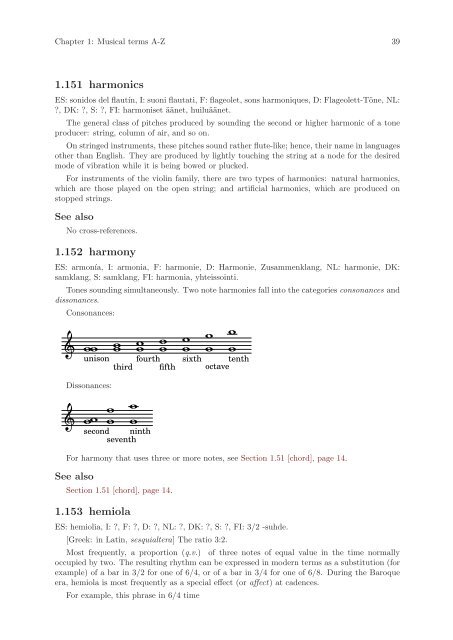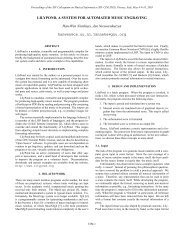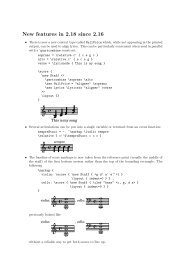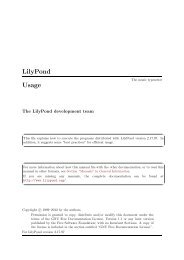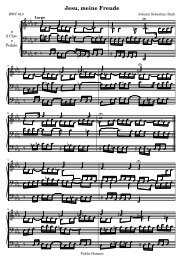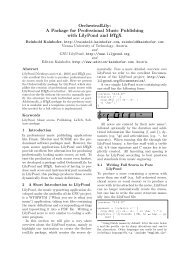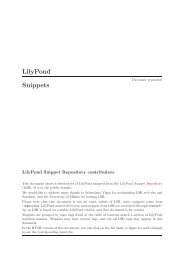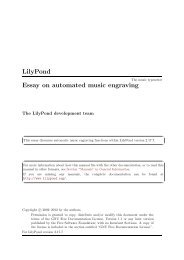Section “slur” in Music Glossary - LilyPond
Section “slur” in Music Glossary - LilyPond
Section “slur” in Music Glossary - LilyPond
You also want an ePaper? Increase the reach of your titles
YUMPU automatically turns print PDFs into web optimized ePapers that Google loves.
Chapter 1: <strong>Music</strong>al terms A-Z 39<br />
1.151 harmonics<br />
ES: sonidos del flautín, I: suoni flautati, F: flageolet, sons harmoniques, D: Flageolett-Töne, NL:<br />
?, DK: ?, S: ?, FI: harmoniset äänet, huiluäänet.<br />
The general class of pitches produced by sound<strong>in</strong>g the second or higher harmonic of a tone<br />
producer: str<strong>in</strong>g, column of air, and so on.<br />
On str<strong>in</strong>ged <strong>in</strong>struments, these pitches sound rather flute-like; hence, their name <strong>in</strong> languages<br />
other than English. They are produced by lightly touch<strong>in</strong>g the str<strong>in</strong>g at a node for the desired<br />
mode of vibration while it is be<strong>in</strong>g bowed or plucked.<br />
For <strong>in</strong>struments of the viol<strong>in</strong> family, there are two types of harmonics: natural harmonics,<br />
which are those played on the open str<strong>in</strong>g; and artificial harmonics, which are produced on<br />
stopped str<strong>in</strong>gs.<br />
See also<br />
No cross-references.<br />
1.152 harmony<br />
ES: armonía, I: armonia, F: harmonie, D: Harmonie, Zusammenklang, NL: harmonie, DK:<br />
samklang, S: samklang, FI: harmonia, yhteisso<strong>in</strong>ti.<br />
Tones sound<strong>in</strong>g simultaneously. Two note harmonies fall <strong>in</strong>to the categories consonances and<br />
dissonances.<br />
Consonances:<br />
<br />
<br />
<br />
<br />
unison<br />
Dissonances:<br />
<br />
<br />
<br />
fourth<br />
third fifth<br />
<br />
<br />
second n<strong>in</strong>th<br />
seventh<br />
sixth<br />
<br />
<br />
tenth<br />
octave<br />
For harmony that uses three or more notes, see <strong>Section</strong> 1.51 [chord], page 14.<br />
See also<br />
<strong>Section</strong> 1.51 [chord], page 14.<br />
1.153 hemiola<br />
ES: hemiolia, I: ?, F: ?, D: ?, NL: ?, DK: ?, S: ?, FI: 3/2 -suhde.<br />
[Greek: <strong>in</strong> Lat<strong>in</strong>, sesquialtera] The ratio 3:2.<br />
Most frequently, a proportion (q.v.) of three notes of equal value <strong>in</strong> the time normally<br />
occupied by two. The result<strong>in</strong>g rhythm can be expressed <strong>in</strong> modern terms as a substitution (for<br />
example) of a bar <strong>in</strong> 3/2 for one of 6/4, or of a bar <strong>in</strong> 3/4 for one of 6/8. Dur<strong>in</strong>g the Baroque<br />
era, hemiola is most frequently as a special effect (or affect) at cadences.<br />
For example, this phrase <strong>in</strong> 6/4 time


